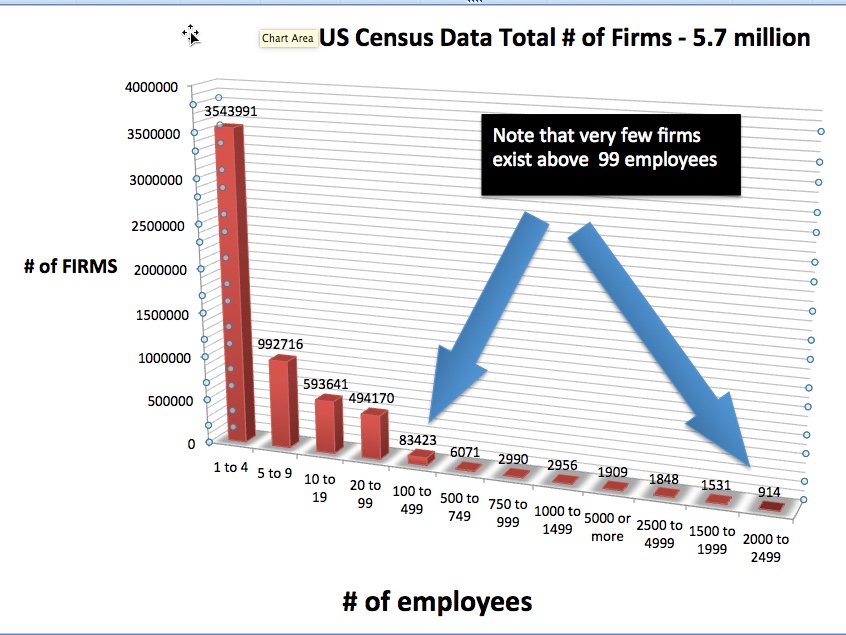Let’s assume you are running a business with between 2 and 499 employees. You represent 99.69% of American based firms! There are only 18,000 firms employing 500 employees or more. But these larger firms are important, they employ just over 50% of America.
So as the owner of a business of the 99%, you are on a journey from the left to the right of the graph. And it’s possible to move from left to right with increasing speed. It took Google only 18 years to move from the left (founded Sept 4th 1998) to the right (2016 full time headcount 72,000). We tend to call this journey – scaling. Now you don’t have to scale. You can absolutely pick your perfect size for you. A software company call Basecamp (was 37 signals) has around 52 employees but seems to feel very happy, safe and successful at that size. So one measurement of success as you scale is definitely headcount but are you really more valuable as you grow? I would argue a better measure, as you scale your business, is to measure success through the lens of an acquirer. This simple approach has the potential to increase shareholder value dramatically, whilst improving the lives of your customers. Let’s look at a very well run business from top to bottom and pause to consider what an acquirer sees (check out my latest book, The Acquirer’s Playbook for more detail).
Positioning
You’ve defined your unique market and you have a clear messaging strategy across all your collateral and all your channels. This is where remarkable content is created and smart marketing campaigns are born. An acquirer sees an effective, focused operator who is clear on why they can win. An acquirer is not confused who you are and is probably clear on how you might be integrated into their business.
Integrated Sales Process
Your new sales process, integrated with your messaging, ensures an efficient filtering of prospects and a compelling dialogue with decision makers leading to an impressive sales growth curve. An acquirer sees a powerful sales team with an effective blueprint. The sales team are aligned with their marketing and product management teams. They appreciate the sales team can sell value and not be trapped in a downward spiral of commodity pricing.
Product Creation & Roadmaps
The development team are integrated to the “voice of the customer” approach, aligned to the marketing, sales and operations teams. They understand products that the market needs and the necessary functionality to win. An acquirer sees an innovative company that has built a system that understands their market. The acquirer understands that you may have failed some of the time, but importantly, you have operationalized an innovative culture that has self-awareness of where they are heading, relative to the market.
Talent Pool
You’ve created an approach to recruitment to capture the best talent when you need it. You have reconfigured an internal training of existing talent through the creation of an internal University. You are always on the lookout for great talent. You understand that your story is not just about the audience of sales prospects but also about candidate prospects. An acquirer never has enough talent, so acquisitions are an effective way of bringing in great talent into an organization. A review of almost all acquisitive groups will demonstrate that great talent can be acquired through deals and incentivized to stay. (Google bat way above the averages as an example, with retention of around 66% of acquired CEOs)
Metrics
By creating a set of key performance indicators (KPIs) both financial and non-financial that measure the right stuff, you understand why you succeed and why you fail. Your reporting demonstrates how actions are taken based on the metrics. It’s clear you audit the signals, and therefore remain agile and alert to change and threats. An acquirer’s biggest risk will always be around the post-acquisition integration of the deal. Great metrics management demonstrates to an acquirer that this management team know how to run a business especially if the environment gets tough. It also makes it much easier for an acquirer to really understand your business and appreciate it hopefully leading to a fully priced offer one day.
These are some of the examples that demonstrate why standing in the shoes of an acquirer can help to ensure your team are focused on the right stuff.
TPP offers operational expertise to scale your business organically or by acquisition. We continue to transform visions into remarkable businesses (and we are always guided by how an acquirer thinks).
Further reading: Closing Valuation Gaps.









